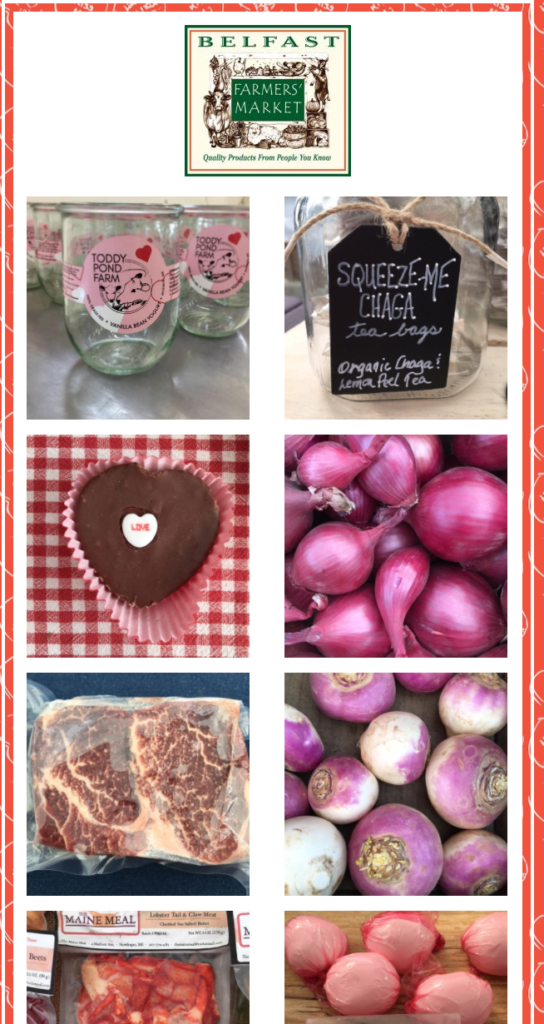
E-newsletters are a great outreach tool for farmers’ markets, for good reasons:
- They are free
- It’s okay to start small
- Regular newsletters keep the market on shoppers’ minds
- They can be a team or individual project
- They create a record of the market’s story
Just getting started? Here are some tips to keep in mind:
- MailChimp and Constant Contact are the most common newsletter apps. The former is free, no matter how large your mailing list, and the latter is often considered more user-friendly. Both manage the logistics of managing a newsletter, including allowing recipients to unsubscribe and tracking cool analytics (like which links in your newsletter received the most clicks). Be sure to set up a template for your newsletter, and then for each new campaign you can simply drop in content.
- It’s never too early to start collecting email addresses, even if you aren’t planning to start a newsletter in the near future. Don’t add addresses to your mailing list without the permission of the address recipient. By the same token, make it easy for people to sign up for your newsletter.
- Maintain your newsletter mailing list regularly. If you use one of the services listed above, they will provide you with a list of addresses that didn’t work, and often you can fix those easily (for example, if the address [email protected] bounced, you’ll know why). Keep a list of people who have expressed interest in your newsletter, and add them to the list regularly. (You won’t want to do that the minutes before your next newsletter is ready to go.)
- Find a way to include lots of pictures. Anyone with a smart phone can snap pictures, but try to do so thoughtfully. That means taking a few seconds to frame the picture carefully. Things to avoid: anything ugly (back of heads, junk piled in the background), anything illegal (no food safety violations, please), anything that might otherwise turn shoppers off (dogs sniffing a display in the corner of a shot). Things to include: appealing products at market, market vendors (don’t be afraid to ask them to pose!), landscape photos that help orient viewers to the market, and photos of happy shoppers. (If you want to use a photo that shows shoppers’ faces, it’s wise to ask first, particularly if there are children.)
- Read other market’s newsletters for ideas. Some good examples are those from the Bath, Belfast, and Orono farmers’ markets.
Looking for ideas for your newsletter?

Some markets use a tag-team approach, with several people (usually volunteers) contributing different parts of the newsletter. An easy way to do this is to use Google docs (a platform that allows multiple people to edit the same document) to collect the newsletter content. (Don’t bother doing much formatting in Google docs, though, as you’ll need to do most of the formatting in your newsletter app.) A more common approach is to have one volunteer who produces each edition of the newsletter. That volunteer usually solicits input from all the market members (and the success of the resulting newsletter is usually in direct proportion to the number of vendors who send along snippets of information or photos to include). Here is some advice from Maine market newsletter editors:
- Give yourself plenty of time-to get info, to write, and to think it through, but don’t let perfect be the enemy of the good! (A cheerful, informative newsletter with a few typos is better than no newsletter at all.)
- Get to know your vendors, and find out what they want in a newsletter/outreach. Solicit whatever they will give you (e.g. recipes, specials, pictures of the piglets…) to add dimension and pull in customers to their world.
- Highlight particular vendors in some way regularly, but make sure the coverage is balanced so that everybody gets roughly equal ink
- Try a color theme – pink for Valentine’s Day, green for St. Patrick’s Day, etc…
- Don’t be surprised if vendors don’t read every issue – just keep going and checking in about what they have, and what they are up to.
- If time permits, cover events your farmers do at home, like Maine Maple Sunday or farm stands, or wine pairings with local winery, local festivals, open houses, and links to other related local stuff, enhancing the community feel of the market.
- Highlight anything new and/or different (sometimes several times!)
- Remember that many, if not most, of your newsletter readers will be viewing it on a small device, so try to avoid long passages of text.
- Keep it timely, focusing on popular foods, trends, and how to’s for anything new.
- Consider using your newsletter content in other places. It’s easy to post the newsletter to social media, but you might also want to pull out photos for individual posts, or for the market’s website.
- Try to stick to a schedule. (Ideally, the newsletter will come out a day or two before each market, as a reminder to shoppers. Every other week could work as well.) Consider sending out at least a few newsletters during the off season, to keep the market in the minds of your customers.
- Get all the help you can!
Special thanks to Caitlyn Hunter (Belfast Farmers’ Market) and Joan Detel (Bath Farmers’ Market) for contributing ideas and suggestions to this article! If you’d like to share your newsletter tips, please send them to [email protected].